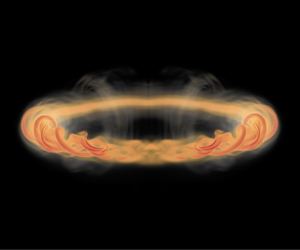Article contents
Vortex bursting and associated twist dynamics on helical vortex tubes and vortex rings
Published online by Cambridge University Press: 10 May 2024
Abstract

The interaction of opposite-signed twist waves on vortex tubes can lead to vortex bursting, a process where the core expands into a double ring-like structure with strong swirling flows. Previous works have studied vortex bursting on rectilinear vortices by axially perturbing the initial core size to generate the twist waves, and observed largely axisymmetric bursting dynamics. In this work, we numerically study bursting on vortical structures with curved centrelines, analysing the interaction between the centreline dynamics, twist wave generation and propagation, and vortex bursting. We focus on axially perturbed helical vortex tubes with small radius-to-pitch ratios up to  $0.0625$, as well as vortex rings with a large radius-to-core size ratio
$0.0625$, as well as vortex rings with a large radius-to-core size ratio  $10$, both at a circulation-based Reynolds number
$10$, both at a circulation-based Reynolds number  $5000$. The results show that though the initial twist wave propagation speeds are relatively unaffected by the curvature and torsion of the centreline, the bursting process is altered significantly compared with rectilinear vortices. The self-induced rotation of the centreline of the helical tube induces a non-axisymmetric distortion of the bursting structure, which rapidly breaks up the vortex core into small-scale helical structures. A similar destabilization of the bursting structure also occurs on vortex rings. The enstrophy increase and accelerated energy decay associated with bursting are predominantly determined by the twist wave strength, rather than the curvature and torsion of the centreline. Combined, our findings imply that bursting could play an important role in transferring and dissipating energy of vortical structures in wakes, and turbulent flows in general.
$5000$. The results show that though the initial twist wave propagation speeds are relatively unaffected by the curvature and torsion of the centreline, the bursting process is altered significantly compared with rectilinear vortices. The self-induced rotation of the centreline of the helical tube induces a non-axisymmetric distortion of the bursting structure, which rapidly breaks up the vortex core into small-scale helical structures. A similar destabilization of the bursting structure also occurs on vortex rings. The enstrophy increase and accelerated energy decay associated with bursting are predominantly determined by the twist wave strength, rather than the curvature and torsion of the centreline. Combined, our findings imply that bursting could play an important role in transferring and dissipating energy of vortical structures in wakes, and turbulent flows in general.
JFM classification
Information
- Type
- JFM Papers
- Information
- Copyright
- © The Author(s), 2024. Published by Cambridge University Press
References
Ji and van Rees supplementary movie 1
Ji and van Rees supplementary movie 2
Ji and van Rees supplementary movie 3
Ji and van Rees supplementary movie 4
Ji and van Rees supplementary movie 5
Ji and van Rees supplementary movie 6
Ji and van Rees supplementary movie 7
Ji and van Rees supplementary movie 8
Ji and van Rees supplementary movie 9
- 1
- Cited by


